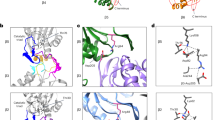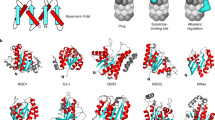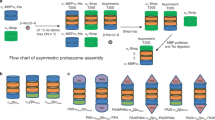Abstract
The 26S proteasome holoenzyme is formed by the association of a 20S core particle (CP) with a 19S regulatory particle (RP). The CP-RP interaction is labile and subject to regulation in vivo, but the factors controlling this association are poorly understood. Here we describe an in vitro proteasome reconstitution assay and a high-resolution, two-dimensional gel electrophoresis system. Using these techniques, we find that a yeast CP–RP complex can contain a substoichiometric amount of tightly bound, essentially non-exchangeable ATP. However, this nucleotide is dispensable for gating of the CP channel, provided that the CP–RP complex is preserved by the Ecm29 protein. Unexpectedly, proteasome inhibitors are potent in stabilizing proteasomes against the dissociation of CP–RP. These data indicate that active sites of the CP communicate with bound RP, despite their spatial separation. We propose that ongoing protein degradation may suppress proteasome disassembly, thereby enhancing the processivity of proteolysis.
This is a preview of subscription content, access via your institution
Access options
Subscribe to this journal
Receive 12 print issues and online access
$189.00 per year
only $15.75 per issue
Buy this article
- Purchase on Springer Link
- Instant access to full article PDF
Prices may be subject to local taxes which are calculated during checkout







Similar content being viewed by others
References
Elsasser, S. & Finley, D. Delivery of ubiquitinated substrates to protein-unfolding machines. Nat. Cell Biol. 7, 742–749 (2005).
Pickart, C.M. & Cohen, R.E. Proteasomes and their kin: proteases in the machine age. Nat. Rev. Mol. Cell Biol. 5, 177–187 (2004).
Maupin-Furlow, J.A. et al. Proteasomes from structure to function: perspectives from Archaea. Curr. Top. Dev. Biol. 75, 125–169 (2006).
Smith, D.M. et al. Docking of proteasomal ATPases' carboxyl termini in the 20S proteasomal alpha ring opens the gate for substrate entry. Mol. Cell 27, 731–744 (2007).
Groll, M. et al. A gated channel into the proteasome core particle. Nat. Struct. Biol. 7, 1062–1067 (2000).
Glickman, M.H. et al. A subcomplex of the proteasome regulatory particle required for ubiquitin-conjugate degradation and related to the COP9-signalosome and eIF3. Cell 94, 615–623 (1998).
Verma, R. et al. Role of Rpn11 metalloprotease in deubiquitination and degradation by the 26S proteasome. Science 298, 611–615 (2002).
Yao, T. & Cohen, R.E. A cryptic protease couples deubiquitination and degradation by the proteasome. Nature 419, 403–407 (2002).
Hartmann-Petersen, R., Tanaka, K. & Hendil, K.B. Quaternary structure of the ATPase complex of human 26S proteasomes determined by chemical cross-linking. Arch. Biochem. Biophys. 386, 89–94 (2001).
Nandi, D., Tahiliani, P., Kumar, A. & Chandu, D. The ubiquitin-proteasome system. J. Biosci. 31, 137–155 (2006).
Liu, C.W. et al. ATP binding and ATP hydrolysis play distinct roles in the function of 26S proteasome. Mol. Cell 24, 39–50 (2006).
Hoffman, L., Pratt, G. & Rechsteiner, M. Multiple forms of the 20 S multicatalytic and the 26 S ubiquitin/ATP-dependent proteases from rabbit reticulocyte lysate. J. Biol. Chem. 267, 22362–22368 (1992).
Armon, T., Ganoth, D. & Hershko, A. Assembly of the 26 S complex that degrades proteins ligated to ubiquitin is accompanied by the formation of ATPase activity. J. Biol. Chem. 265, 20723–20726 (1990).
Eytan, E., Ganoth, D., Armon, T. & Hershko, A. ATP-dependent incorporation of 20S protease into the 26S complex that degrades proteins conjugated to ubiquitin. Proc. Natl. Acad. Sci. USA 86, 7751–7755 (1989).
Smith, D.M. et al. ATP binding to PAN or the 26S ATPases causes association with the 20S proteasome, gate opening, and translocation of unfolded proteins. Mol. Cell 20, 687–698 (2005).
Satoh, K., Sasajima, H., Nyoumura, K.I., Yokosawa, H. & Sawada, H. Assembly of the 26S proteasome is regulated by phosphorylation of the p45/Rpt6 ATPase subunit. Biochemistry 40, 314–319 (2001).
Leggett, D.S. et al. Multiple associated proteins regulate proteasome structure and function. Mol. Cell 10, 495–507 (2002).
Stanhill, A. et al. An arsenite-inducible 19S regulatory particle-associated protein adapts proteasomes to proteotoxicity. Mol. Cell 23, 875–885 (2006).
Imai, J., Maruya, M., Yashiroda, H., Yahara, I. & Tanaka, K. The molecular chaperone Hsp90 plays a role in the assembly and maintenance of the 26S proteasome. EMBO J. 22, 3557–3567 (2003).
Schmidt, M. et al. The HEAT repeat protein Blm10 regulates the yeast proteasome by capping the core particle. Nat. Struct. Mol. Biol. 12, 294–303 (2005).
Park, Y. et al. Proteasomal ATPase-associated factor 1 negatively regulates proteasome activity by interacting with proteasomal ATPases. Mol. Cell. Biol. 25, 3842–3853 (2005).
Leggett, D.S., Glickman, M.H. & Finley, D. Purification of proteasomes, proteasome subcomplexes, and proteasome-associated proteins from budding yeast. Methods Mol. Biol. 301, 57–70 (2005).
Bajorek, M., Finley, D. & Glickman, M.H. Proteasome disassembly and downregulation is correlated with viability during stationary phase. Curr. Biol. 13, 1140–1144 (2003).
Vernace, V.A., Arnaud, L., Schmidt-Glenewinkel, T. & Figueiredo-Pereira, M.E. Aging perturbs 26S proteasome assembly in Drosophila melanogaster. FASEB J. 21, 2672–2682 (2007).
Babbitt, S.E. et al. ATP hydrolysis-dependent disassembly of the 26S proteasome is part of the catalytic cycle. Cell 121, 553–565 (2005).
Hendil, K.B., Hartmann-Petersen, R. & Tanaka, K. 26 S proteasomes function as stable entities. J. Mol. Biol. 315, 627–636 (2002).
Rubin, D.M., Glickman, M.H., Larsen, C.N., Dhruvakumar, S. & Finley, D. Active site mutants in the six regulatory particle ATPases reveal multiple roles for ATP in the proteasome. EMBO J. 17, 4909–4919 (1998).
Kohler, A. et al. The axial channel of the proteasome core particle is gated by the Rpt2 ATPase and controls both substrate entry and product release. Mol. Cell 7, 1143–1152 (2001).
Forster, A., Masters, E.I., Whitby, F.G., Robinson, H. & Hill, C.P. The 1.9 Å structure of a proteasome-11S activator complex and implications for proteasome-PAN/PA700 interactions. Mol. Cell 18, 589–599 (2005).
Smith, D.M., Benaroudj, N. & Goldberg, A. Proteasomes and their associated ATPases: a destructive combination. J. Struct. Biol. 156, 72–83 (2006).
Saeki, Y., Toh-e, A. & Yokosawa, H. Rapid isolation and characterization of the yeast proteasome regulatory complex. Biochem. Biophys. Res. Commun. 273, 509–515 (2000).
Kleijnen, M.F. et al. The hPLIC proteins may provide a link between the ubiquitination machinery and the proteasome. Mol. Cell 6, 409–419 (2000).
Groll, M., Kim, K.B., Kairies, N., Huber, R. & Crews, C.M. Crystal structure of epoxomicin: 20S proteasome reveals a molecular basis for selectivity of α′,β′-epoxyketone proteasome inhibitors. J. Am. Chem. Soc. 122, 1237–1238 (2000).
Groll, M., Berkers, C.R., Ploegh, H.L. & Ovaa, H. Crystal structure of the boronic acid-based proteasome inhibitor bortezomib in complex with the yeast 20S proteasome. Structure 14, 451–456 (2006).
Meng, L. et al. Epoxomicin, a potent and selective proteasome inhibitor, exhibits in vivo antiinflammatory activity. Proc. Natl. Acad. Sci. USA 96, 10403–10408 (1999).
Berkers, C.R. et al. Activity probe for in vivo profiling of the specificity of proteasome inhibitor bortezomib. Nat. Methods 2, 357–362 (2005).
Arendt, C.S. & Hochstrasser, M. Eukaryotic 20S proteasome catalytic subunit propeptides prevent active site inactivation by N-terminal acetylation and promote particle assembly. EMBO J. 18, 3575–3585 (1999).
Joshi, S.A., Hersch, G.L., Baker, T.A. & Sauer, R.T. Communication between ClpX and ClpP during substrate processing and degradation. Nat. Struct. Mol. Biol. 11, 404–411 (2004).
Singh, S.K., Guo, F. & Maurizi, M.R. ClpA and ClpP remain associated during multiple rounds of ATP-dependent protein degradation by ClpAP protease. Biochemistry 38, 14906–14915 (1999).
Chu-Ping, M., Vu, J.H., Proske, R.J., Slaughter, C.A. & DeMartino, G.N. Identification, purification, and characterization of a high molecular weight, ATP-dependent activator (PA700) of the 20 S proteasome. J. Biol. Chem. 269, 3539–3547 (1994).
Elsasser, S., Schmidt, M. & Finley, D. Characterization of the proteasome using native gel electrophoresis. Methods Enzymol. 398, 353–363 (2005).
Yang, P. et al. Purification of the Arabidopsis 26 S proteasome: biochemical and molecular analyses revealed the presence of multiple isoforms. J. Biol. Chem. 279, 6401–6413 (2004).
Arendt, C.S. & Hochstrasser, M. Identification of the yeast 20S proteasome catalytic centers and subunit interactions required for active-site formation. Proc. Natl. Acad. Sci. USA 94, 7156–7161 (1997).
Acknowledgements
We thank M. Hochstrasser (Yale University) for yeast strains; Millennium Pharmaceuticals for PS-341; M. Maurizi, D.S. Newburg, and members of the Finley laboratory, especially J. Hanna and N. Sofaer, for reading the manuscript and for insightful comments; and the ICCB screening facility at Harvard Medical School for use of their facility. This research was supported by grants from the US National Institutes of Health grants to D.F. (GM43601) and R.W.K. (GM66492).
Author information
Authors and Affiliations
Corresponding author
Supplementary information
Supplementary Text and Figures
Supplementary Figures 1–6, Supplementary Table 1, Supplementary Methods (PDF 894 kb)
Rights and permissions
About this article
Cite this article
Kleijnen, M., Roelofs, J., Park, S. et al. Stability of the proteasome can be regulated allosterically through engagement of its proteolytic active sites. Nat Struct Mol Biol 14, 1180–1188 (2007). https://doi.org/10.1038/nsmb1335
Received:
Accepted:
Published:
Issue Date:
DOI: https://doi.org/10.1038/nsmb1335
This article is cited by
-
Allosteric regulation of the 20S proteasome by the Catalytic Core Regulators (CCRs) family
Nature Communications (2023)
-
Allosteric coupling between α-rings of the 20S proteasome
Nature Communications (2020)
-
Tagging the proteasome active site β5 causes tag specific phenotypes in yeast
Scientific Reports (2020)
-
Quantifying the heterogeneity of macromolecular machines by mass photometry
Nature Communications (2020)
-
Regulation of proteasome assembly and activity in health and disease
Nature Reviews Molecular Cell Biology (2018)



